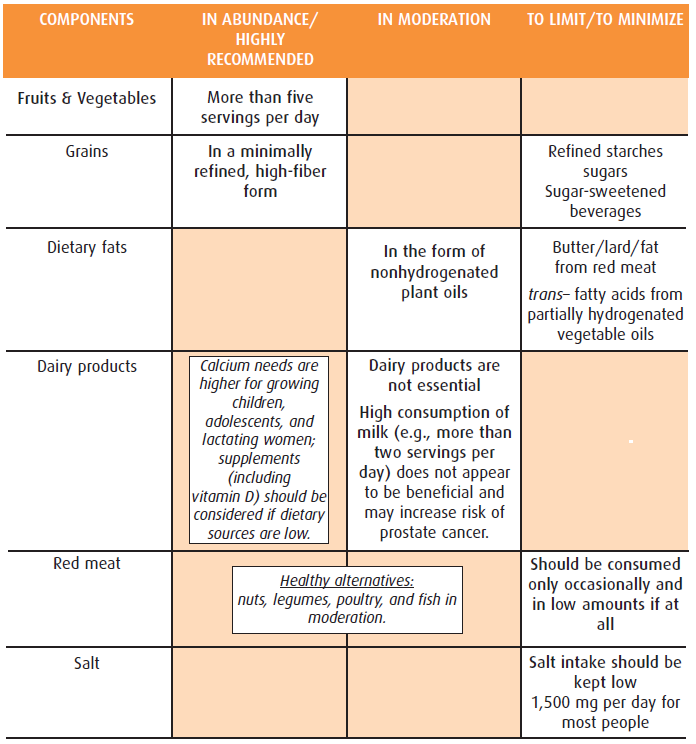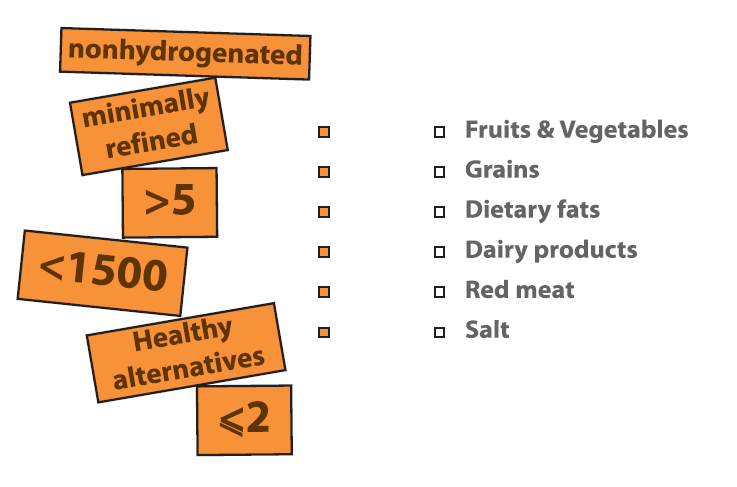What are the recommendations and where is the place of fruits and vegetables in a healthy diet?
There is an enormous body of evidence from studies that range from molecular biology of nutrients to population-level interventions. Distilling this information to practical advice on healthy eating represents a major challenge. As our knowledge is rapidly increasing and becoming more refined and detailed, recommendations require frequent updating.
Dietary recommendations: a permanent updating
Until the past couple of decades, a primary focus of human nutrition was the prevention of nutrient deficiency, and achieving the recommended daily allowances (RDAs)1 for essential nutrients was the central objective. This approach led to the development of the Basic Seven food groups during World War II and later the Basic Four (meat, dairy, grains, and fruits and vegetables) as the definition of a healthy diet to be conveyed to the public2. This effort, together with selective fortification and greater availability of food variety, successfully eliminated most clinically evident nutrient deficiencies from the United States and Europe. More recently, the definition of a healthy diet has expanded to focus more broadly on the optimization of long-term health, accounting for subclinical dietary insufficiencies as well as excesses.
Elements of a healthy diet can be expressed as foods or nutrients. Using foods is attractive because it is familiar and makes choice and communication easier. Unfortunately, it is virtually impossible to describe an optimal diet only in terms of foods. The main reason is that the same foods can be made in many ways. Besides, the proportion of the food supply that is already processed or is eaten away from home increases. Most guidelines are hybrids that use a combination of food and nutrient criteria.
What about fruits and vegetables?
Fruits and vegetables are the only food recommended as such in many written guidelines. Increasing intakes of fruit and vegetables is a crucial part of the main food-related approaches to preventing noncommunicable diseases.
Much of the advice to eat more vegetables and fruits3 has been based on hopes of reducing cancer. However, after adjusting for differences in other lifestyle factors such as smoking and body mass index, most cohort studies show much weaker—or no—relation between overall fruit and vegetable consumption and risks of common cancers4-7. However, investigators have seen inverse relationships for renal cell11 and estrogen receptor-negative breast cancer8. There may be some benefit for specific fruits or vegetables against specific cancers. For example, some evidence suggests that lycopene, mainly from tomato products, reduces risk of advanced prostate cancer9,10.
In contrast, substantial epidemiologic evidence consistently supports a benefit of higher intake of fruit and vegetable consumption for cardiovascular disease11. High intake of vegetables reduces blood pressure12; the active factors remain unclear, but potassium is a likely contributor13. Other benefits of higher fruit and vegetable intake likely include lower risk of neural tube defects, the most common severe birth defect14, due to higher folic acid intake. Intake of the carotenoids lutein and zeaxanthin, which are high in green leafy vegetables, has been inversely related to risk of cataracts15,16. The benefits of fruit do not necessarily extend in the same manner to juice. Juice typically contains less fiber, and because of the natural sugar content, and because large quantities can be consumed rapidly, it contributes to weight gain and glucose intolerance17.
Current Recommendations for a healthy diet
Information regarding optimal diets continues to evolve, and recommendations must be tempered by the recognition that information will always be incomplete. In particular, the long-term influence of diet in early life requires decades of study.
Although our data are evolving, we may draw some general conclusions, based on data from epidemiologic studies, trials, and metabolic and laboratory studies, which are unlikely to change substantially. Fruits and vegetables are essential foods in a healthy diet, and their daily consumption is highly recommended across all dietary guidelines.

Other recommendations should be drawn:
- Fruit juice should be limited to not more than ∼1 small glass per day.
- Moderate alcohol can be part of a healthy diet for those in whom it is not contraindicated (up to one drink per day for women and up to two for men).
- For most people, taking a daily RDA level (DV) multiple vitamins containing 1,000 to 2,000 IU of vitamin D provides a sensible nutritional safety net.
Physical activity must be also integrated in these recommendations for a healthy lifestyle. Staying lean and active throughout life will have major health benefits. Because most people in developed countries work at sedentary jobs, weight control will usually require daily physical activity and some effort to avoid overconsumption of calories.
At the international level, institutions and governments have identified unhealthy diet and physical inactivity as important NCD risk factors. Priority concerns have included excessive intake of energy, saturated fats and trans fats, free sugars and salt, as well as low consumption of vegetables and fruits. However, policies to promote F&V consumption by making them widely available and affordable have usually been inadequate.

BASED ON: Willett WC, Stampfer MJ. Current evidence on healthy eating. Annu Rev Public Health. 2013;34:77-95.
References
- Food Nutr. Board. 1989. Recommended Dietary Allowances. Washington, DC: Natl. Acad. Sci. 10th rev. ed.
- Hayes O, et al.. 1955. Suggested revisions of the Basic 7. J. Am. Diet Assoc. 31:1103–7
- Natl. Res. Counc. Comm. on Diet and Health. 1989. Diet and Health: Implications for Reducing Chronic Disease Risk. Washington, DC: Natl. Acad. Press
- Boffetta P et al. 2010. Fruit and vegetable intake and overall cancer risk in the European Prospective Investigation into Cancer and Nutrition (EPIC). J. Natl. Cancer Inst. 102:529–37
- Koushik A, et al. 2007. Fruits, vegetables, and colon cancer risk in a pooled analysis of 14 cohort studies. J. Natl. Cancer Inst. 99:1471–83
- Smith-Warner SA, et al. 2001. Intake of fruits and vegetables and risk of breast cancer: a pooled analysis of cohort studies. JAMA 285:769–76
- Smith-Warner SA, et al. 2003. Fruits, vegetables and lung cancer: a pooled analysis of cohort studies. Int. J. Cancer 107:1001–11
- Fung TT, et al. 2005. Dietary patterns and the risk of postmenopausal breast cancer. Int. J. Cancer 116:116–21
- Giovannucci E. 1999. Tomatoes, tomato-based products, lycopene, and cancer: review of the epidemiologic literature. J. Natl. Cancer Inst. 91:317–31
- World Cancer Res. Fund, Am. Inst. Cancer Res. 2007. Food, Nutrition, Physical Activity, and the Prevention of Cancer: A Global Perspective. Second Expert Rep. London: WCRF.
- Hung HC, et al. 2004. Fruit and vegetable intake and the risk of major chronic disease. J. Natl. Cancer Inst. 21:1577–84
- Sacks FM, et al. 2001. Effects on blood pressure of reduced dietary sodium and the dietary approaches to stop hypertension (DASH) diet. N. Engl. J. Med. 344:3–10
- Sacks FM, et al.. 1998. Effect on blood pressure of potassium, calcium, and magnesium in women with low habitual intake. Hypertension 31:131–38
- Werler MM, et al. 1993. Periconceptional folic acid exposure and risk of occurrent neural tube defects. JAMA 269:1257–61
- Brown L et al. 1999. A prospective study of carotenoid intake and risk of cataract extraction in US men. Am. J. Clin. Nutr. 70:517–2421. Bazzano LA et al. 2008. Intake of fruit, vegetables, and fruit juices and risk of diabetes in women. Diabetes Care 31:1311–17
- Chasan-Taber L et al. 1999. A prospective study of carotenoid and vitamin A intakes and risk of cataract extraction in US women. Am. J. Clin. Nutr. 70:509–16
- Bazzano LA, Li TY, Joshipura KJ, Hu FB. 2008. Intake of fruit, vegetables, and fruit juices and risk ofdiabetes in women. Diabetes Care 31:1311–17
